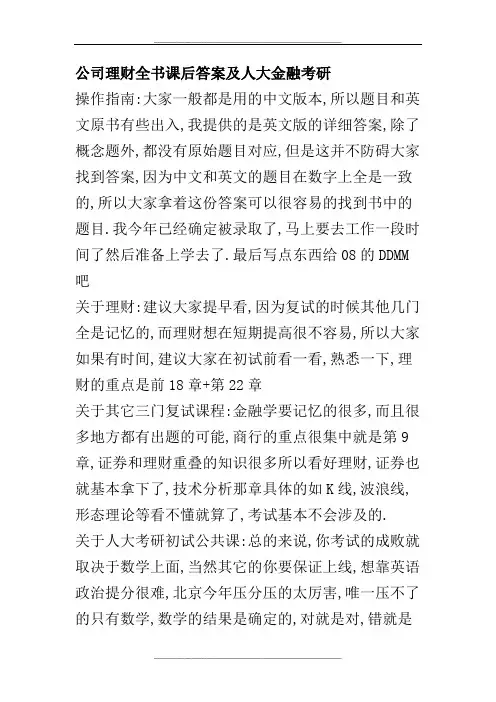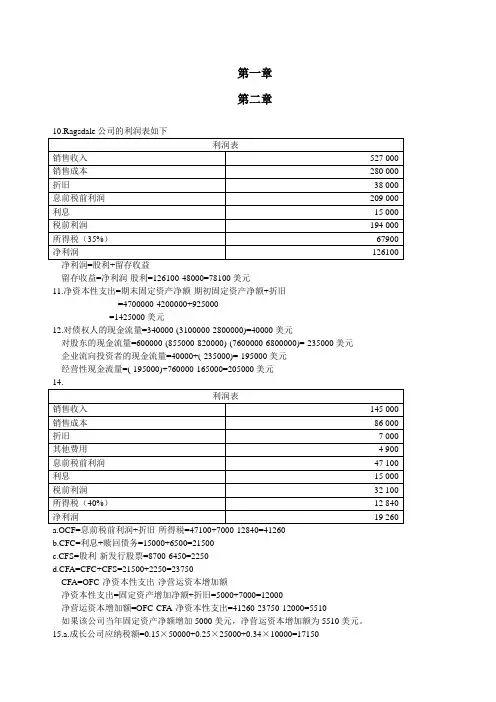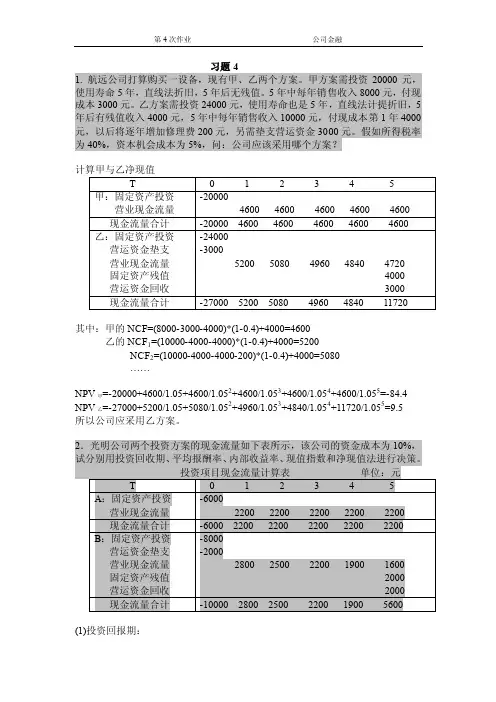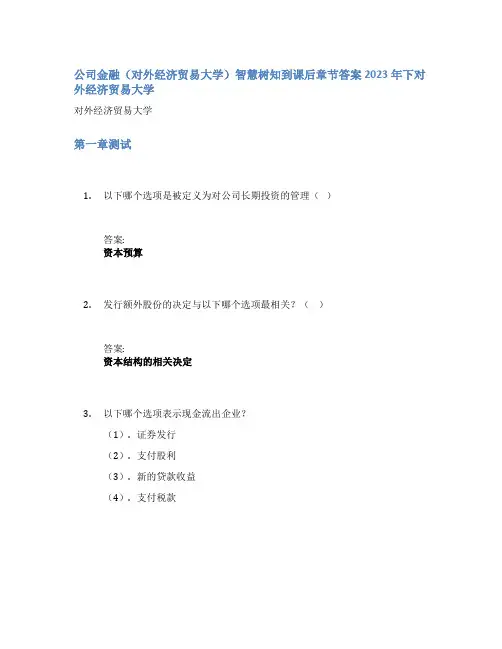公司金融 李心愉 第四章课后习题答案
公司理财全书课后答案及人大金融考研

公司理财全书课后答案及人大金融考研操作指南:大家一般都是用的中文版本,所以题目和英文原书有些出入,我提供的是英文版的详细答案,除了概念题外,都没有原始题目对应,但是这并不防碍大家找到答案,因为中文和英文的题目在数字上全是一致的,所以大家拿着这份答案可以很容易的找到书中的题目.我今年已经确定被录取了,马上要去工作一段时间了然后准备上学去了.最后写点东西给08的DDMM 吧关于理财:建议大家提早看,因为复试的时候其他几门全是记忆的,而理财想在短期提高很不容易,所以大家如果有时间,建议大家在初试前看一看,熟悉一下,理财的重点是前18章+第22章关于其它三门复试课程:金融学要记忆的很多,而且很多地方都有出题的可能,商行的重点很集中就是第9章,证券和理财重叠的知识很多所以看好理财,证券也就基本拿下了,技术分析那章具体的如K线,波浪线,形态理论等看不懂就算了,考试基本不会涉及的.关于人大考研初试公共课:总的来说,你考试的成败就取决于数学上面,当然其它的你要保证上线,想靠英语政治提分很难,北京今年压分压的太厉害,唯一压不了的只有数学,数学的结果是确定的,对就是对,错就是错,但英语政治2卷就不然,你的作文觉得能拿15分,老师就是给你3分你能怎么样呢? 所以劝大家好好学好数学,其他2门中庸一下也不会影响大局,当然对于立志做人大金融第一又或者冲着公费去的DDMM,可以忽略我上面的那段话.推荐几本书吧:数学:基础还行的话直接看二李的复习全书吧不推荐老陈的二李的看3遍然后做660 11月开始做400+真题就足够了我考2次都是这么复习的题目要反复做特别是660 那书你做透了选择填空不会扣分 400最后做按时间严格做做3遍真题再好好看看简单的卷子140 难的这样的分数基本没问题的如果想150 基本要看发挥了政治:看红宝书看3遍不用背但要认真看选择都是那里面的(当然今年有2个题目确实不是,出题的人因此被狂骂)最后一定记得买20天20题那个一定要背每年大题基本都能压到的8月开始准备政治就行了到最后冲刺的时候多花点时间背 75左右没问题的英语: 我只看过真题,看了很多遍.初试专业课:3本指定教材足够了,好好看几遍,重点的东西记忆一下,至于西经计算,考的很EASY的,没时间的话不专门准备也可,IS-LM的计算几乎每年都考,不过很简单的最后祝大家好运,周2回京工作去了,感谢在这里陪我度过考研的每个人.........R,KEVIN,橙子,大K,小鱼...........9月人大见啦~ ~理财答案感谢橙子,这个答案是给我的,很不错,每个题目都有详细的过程,这样让我轻松的在英文中找到了中文原题)CONCEPT部分解决是是所有章节的概念题CONCEPT QUESTIONS - CHAPTER 11.1 · What are the three basic questions of corporate finance?a. Investment decision (capital budgeting): What long-term investment strategy should a firm adopt?b. Financing decision (capital structure): How much cash must be raised for therequired investments?c. Short-term finance decision (working capital): How much short-term cash flow does company need to pay its bills.· Describe capital structure.Capital structure is the mix of different securities used to finance a firm's investments.· List three reasons why value creation is difficult.Value creation is difficult because it is not easy to observe cash flows directly. The reasons are: a. Cash flows are sometimes difficult to identify.b. The timing of cash flows is difficult to determine.c. Cash flows are uncertain and therefore risky.1.2 · What is a contingent claim?A contingent claim is a claim whose payoffs are dependent on the value of the firm at the end ofthe year. In more general terms, contingent claims depend on the value of an underlng asset.· Describe equity and debt as contingent claims. Both debt and equity depend on the value of the firm. If the value of the firm is greater than the amount owed to debt holders, they will get what the firm owes them, while stockholders will get the difference. But if the value of the firm is less than equity, bondholders will get the value of the firm and equity holders nothing.1.3 · Define a proprietorship, a partnership anda corporation.A proprietorship is a business owned by a single individual with unlimited liability. A partnership is a business owned by two or more individuals with unlimited liability. A corporation is a business which is a "legal person" with many limited liability owners.· What are the advantages of the corporate form of business organization?Limited liability, east of ownership transfer and perpetual succession.1.4 · What are the two types of agency costs? Monitoring costs of the shareholders and the incentive fees paid to the managers.· How are managers bonded to shareholders? a. Shareholders determine the membership to the board of directors, which selects management.b. Management contracts and incentives are build into compensation arrangements.c. If a firm is taken over because the firm's price dropped, managers could lose their jobs.d. Competition in the managerial labor market makes managers perform in the best interest of stockholders.· Can you recall some managerial goals?Maximization of corporate wealth, growth and company size.· What is the set-of-contracts perspective? The view of the corporation as a set of contracting relationships among individuals who have conflicting objectives.1.5 · Distinguish between money markets and capital markets.Money markets are markets for debt securities that pay off in less than one year, while capital markets are markets for long-term debt and equity shares.· What is listing?Listing refers to the procedures by which a company applies and qualifies so that its stock can be traded on the New York Stock Exchange.· What is the difference between a primary market and a secondary market?The primary market is the market where issuers of securities sell them for the first time to investors, while a secondary market is a market for securities previously issued.CONCEPT QUESTIONS - CHAPTER 22.1 · What is the balance-sheet equation? Assets = Liabilities + Stockholders' equity· What three things should be kept in mind when looking at a balance sheet?Accounting liquidity, debt vs. equity, and value vs. cost.2.2 · What is the income statement equation? Revenue - expenses = Income· What are the three things to keep in mind when looking at an income statement?Generally Accepted Accounting Principles (GAAP), noncash items, and time and costs.· What are noncash e xpenses?Noncash expenses are items included as expenses but which do not directly affect cash flow. The most important one is depreciation.2.3 · What is net working capital?It is the difference between current assets and current liabilities.· What is the change in net working capital? To determine changes in net working capital you subtract uses of net working capital from sources of net working capital.2.4 · How is cash flow different from changes in net working capital?The difference between cash flow and changes in new working capital is that some transactions affect cash flow and not net working capital. Theacquisition of inventories with cash is a good example of a change in working capital requirements.· What is the difference between opera ting cash flow and total cash flow of the firm?The main difference between the two is capital spending and additions to working capital, that is, investment in fixed assets and "investment" in working capital.CONCEPT QUESTIONS - CHAPTER 33.1 · What i s an interest rate?It is the payment required by the lender of money for the use of it during a determined period of time. It is expressed in percentage.· What are institutions that match borrowers and lenders called?They are called financial institutions.· What do we mean when we say a market clears? What is an equilibrium rate of interest?A market clears if the amount of money borrowers want to borrow is equal to the amount lenders wish to lend. An equilibrium rate of interest is the interest rate at which markets clear.3.2 · How does an individual change his consumption across periods throughborrowing and lending.By borrowing and lending different amounts the person can achieve any of all consumption possibilities available.· How do interest r ate changes affect one's degree of impatience?A person's level of patience depends upon the interest rate he or she faces in the market. A person eager to borrow money at a low interest rate will become less eager if that interest rate is raised and may prefer to lend money to take advantage of higher interest rates.3.3 · What is the most important feature of a competitive financial market?No investor, individual or corporation can have a significant effect on total lending or on interest rates. Therefore, investors are price takers.· What conditions are likely to lead to this?a. Trading is costless.b. Information about borrowing and lending opportunities is availablec. There are many traders.3.4 · Describe the basic financial principle of investment decision-making?An investment project is worth undertaking only if it is mores desirable than what is available in the financial markets.3.5 · Describe how the financial markets can be used to evaluate investmentalternatives?The financial markets can be used as a benchmark. If the proposed investment provides a better alternative than the financial markets, it should be undertaken.· What is the separation theorem? Why is it important?The separation theorem says that the decision as to whether to undertake a project (compared to the financial markets) is independent of the consumption preferences of the individual. It is important because we can make investment decisions based on objective data, disregarding personal preferences.3.6 · Give the definitions of net present value, future value and present value?New present value is the difference in present value terms between cash inflows and cash outflows. Given the financial market, the future value is an amount equivalent to the amountcurrently held, and present value is the amount equivalent to an amount to be received or given in the future.· What information does a person need to compute an investment's net presentvalue?Cash inflows, cash outflows and an interest or discount rate.3.7 · In terms of the net-present-value rule, what is the essential differencebetween the individual and the corporation. The main difference is that firms have no consumption endowment.CONCEPT QUESTIONS - CHAPTER 44.1 · Define future value and present value. Future value is the value of a sum after investing over one or more periods. Present value is thevalue today of cash flows to be received in the future.· How does one use net present value when making an investment decision?One determines the present value of future cash flows and then subtracts the cost of the investment. If this value is positive, the investment should be undertaken. If the NPV is negative, then the investment should be rejected.4.2 · What is the difference between simple interest and compound interest?With simple interest, the interest on the original investment is not reinvested. With compound interest, each interest payment is reinvested and one earns interest on interest.· What is the formula for the net present value of a project?TNPV = -C0 + å Ct /(1+I)tt=14.3 · What is a stated annual interest rate? The stated annual interest rate is the annual interest rate without consideration of compounding.· What is an effective annual interest rate? An effective annual interest rate is a rate that takes compounding into account.· What is the relationship between the stated annual interest rate and the effective annual interest rate?Effective annual interest rate = (1 + (r/m) )m - 1.· Define continuous compoundin g.Continuous compounding compounds investments every instant.4.4 · What are the formulas for perpetuity, growing-perpetuity, annuity, andgrowing annuity?Perpetuity: PV = C/rGrowing Perpetuity: PV = C/(r-g)Annuity: PV = (C/r) [1-1/(1+r)T]Growing Annuity: PV = [C/(r-g)] [1-((1+g) / (1+r))T ]· What are three important points concerning the growing perpetuity formula?1. The numerator.2. The interest rate and the growth rate.3. The timing assumption.· What are four tricks concerning annuities?1. A delayed annuity.2. An annuity in advance3. An infrequent annuity4. The equating of present values of two annuities.CONCEPT QUESTIONS - CHAPTER 55.2 · Define pure discount bonds, level-coupon bonds, and consols.A pure discount bond is one that makes no intervening interest payments. One receives a single lump sum payment at maturity. A level-coupon bond is a combination of an annuity and a lump sum at maturity. A consol is a bond that makes interest payments forever.· Contrast the state interest rate and the effective annual interest rate for bonds pang semi-annual interest.Effective annual interest rate on a bond takes into account two periods of compounding per year received on the coupon payments. The state rate does not take this into account.5.3 · What is the relationship between interest rates and bond prices?There is an inverse relationship. When one goes up, the other goes down.· How does one calculate the eld to maturity on a bond?One finds the discount rate that equates the promised future cash flows with the price of the bond.5.8 · What are the three factors determining a firm's P/E ratio?1. Today's expectations of future growth opportunities.2. The discount rte.3. The accounting method.5.9 · What is the closing price of Gen eral Data? The closing price of General Data is 6 3/16.· What is the PE of General House?The PE of General House is 29.· What is the annual dividend of General Host? The annual dividend of General Host is zero.CONCEPT QUESTIONS - Appendix to Chapter 5· What is the difference between a spot interest rate and the eld to maturity?The eld to maturity is the geometric average of the spot rates during the life of the bond.· Define the forward rate.Given a one-year bond and a two-year bond, one knows the spot rates for both. The forward rate is the rate of return implicit on a one-year bond purchased in the second year that would equate the terminal wealth of purchasing the one-year bond today and another in one year with that of the two-year bond.·What is the relationship between the one-year spot rate, the two-year spot rate and the forward rate over the second year?The forward rate f2 = [(1+r2)2 /(1+r1 )] - 1· What is the expectation hypothesis?Investors set interest rates such that the forward rate over a given period equals the spot rate for that period.What is the liquidity-preference hypothesis? This hypothesis maintains that investors require a risk premium for holding longer-term bonds (i.e. they prefer to be liquid or short-term investors). This implies that the market sets the forward rate for a given period above the expected spot rate for that period.CONCEPT QUESTIONS - CHAPTER 66.2 · List the problems of the payback period rule.1. It does not take into account the time value of money.2. It ignores payments after the payback period.3. The cutoff period is arbitrary.· What are some advantages?1. It is simple to implement.2. It may help in controlling and evaluating managers.6.4 · What are the three steps in calculating AAR?1. Determine average net income.2. Determine average investment3. Divide average net income by average investment.· What are some flaws with the AAR approach?1. It uses accounting figures.2. It takes no account of timing.3. The cutoff period is arbitrary.6.5 · How does one calculate the IRR of a project? Using either trial-and-error or a financial calculator, one finds the discount rate that produces an NPV of zero.6.6 · What is the difference between independentprojects and mutually exclusiveprojects?An independent project is one whose acceptance does not affect the acceptance of another. A mutually exclusive project, on the other hand is one whose acceptance precludes the acceptance of another.· What are two problems with the IRR approach that apply to both independent and mutually exclusive projects?1. The decision rule depends on whether one is investing of financing.2. Multiple rates of return are possible.· What are two additional problems applng only to mutually exclusive projects?1. The IRR approach ignores issues of scale.2. The IRR approach does not accommodate the timing of the cash flows properly.6.7 · How does one calculate a project'sprofitability index?Divide the present value of the cash flows subsequent to the initial investment by the initial investment.· How is the profitability index applied to independent projects, mutually exclusive projects, and situations of capital rationing?1. With independent projects, accept the project if the PI is greater than 1.0 and reject if less than 1.0.2. With mutually exclusive projects, use incremental analysis, subtracting the cash flows of project 2 from project 1. Find the PI. If the PI is greater than 1.0, accept project 1. If less than 1.0, accept project 2.3. In capital rationing, the firm should simply rank the projects according to their respective PIs and accept the projects with the highest PIs, subject to the budget constrain.CONCEPT QUESTIONS - CHAPTER 77.1 · What are the three difficulties in determining incremental cash flows?1. Sunk costs.2. Opportunity costs3. Side effects.· Define sunk costs, opportunity costs, and side effects.1. Sunk costs are costs that have already been incurred and that will not be affected by the decision whether to undertake the investment.2. Opportunity costs are costs incurred by the firm because, if it decides to undertake a project, it will forego other opportunities for using the assets.3. Side effects appear when a project negatively affects cash flows from other parts of the firm.7.2 · What are the items leading to cash flow in any year?Cash flow from operations (revenue-operating costs-taxes) plus cash flow of investment (costof new machines + changes in net working capital + opportunity costs).· Why did we determi ne income when NPV Analysis discounts cash flows, not income?Because we need to determine how much is paid out in taxes.· Why is working capital viewed as a cash outflow?Because increases in working capital must be funded by cash generated elsewhere in the firm.7.3 · What is the difference between the nominal and the real interest rate?The nominal interest rate is the real interest rate with a premium for inflation.· What is the difference between nominal and real cash flows?Real cash flows are nominal cash flows adjusted for inflation.7.4 · What is the equivalent annual cost method of capital budgeting?The decision as to which of various mutually exclusive machines to buy is based on the equivalent annual cost. The EAC is determined by dividing the net present value of costs by an annuity factor that has the same life as the machines. The machine with the lowest EAC should be acquired.· Can you list the assumptions that we must to use EAC?1. All machines do the same job.2. They have different operating costs and lives3. The machine will be indefinitely replaced. CONCEPT QUESTIONS - CHAPTER 88.1 · What are the ways a firm can create positive NPV.1. Be first to introduce a new product.2. Further develop a core competency to product goods or services at lower costs than competitors.3. Create a barrier that makes it difficult for the other firms to compete effectively.4. Introduce variation on existing products to take advantage of unsatisfied demand5. Create product differentiation by aggressive advertising and marketing networks.6. Use innovation in organizational processes to do all of the above.· How can managers use the market to help them screen out negative NPV projects?8.2 · What is a decision tree?It is a method to help capital budgeting decision-makers evaluating projects involving sequential decisions. At every point in the tree, there are different alternatives that should be analyzed.· What are potential problems in using a decision tree?Potential problems 1) that a different discount rate should be used for different branches in the tree and 2) it is difficult for decision trees to capture managerial options.8.3 · What is a sensitivity analysis?It is a technique used to determine how the result of a decision changes when some of the parameters or assumptions change.· Why is it important to perform a sensitivity analysis?Because it provides an analysis of the consequences of possible prediction or assumption errors.· What is a break-even analysis?It is a technique used to determine the volume of production necessary to break even, that is, to cover not only variable costs but fixed costs aswell.· Describe how sensitivity analysis interacts with break-even analysis.Sensitivity analysis can determine how the financial break-even point changes when some factors (such as fixed costs, variable costs, or revenue) change.CONCEPT QUESTIONS - CHAPTER 99.1 · What are the two parts of total return? Dividend income and capital gain (or loss)· Why are unrealized capi tal gains or losses included in the calculation of returns? Because it is as much a part of returns as dividends, even if the investor decides to hold onto the stock and not to realize the capital gain.· What is the difference between a dollar returnand a percentage return?A dollar return is the amount of money the original investment provided, while percentage return is the percentage of the original investment represented by the total return.9.2 · What is the largest one-period return in the 63-year history of commonstocks we have displayed, and when did it occur? What is the smallest return, and when did it occur?Largest common stock return: 53.99% in 1933. Smallest common stock return: -43.34% in 1931.· In how many years did the common stock r eturn exceed 30 percent, and inhow many years was it below 20 percent?It exceeded 30% in 16 years. It was below 20% in 39 years.· For common stocks, what is the longest period of time without a single losingyear? What is the longest streak of losing years? There are 6 consecutive years of positive returns. The longest losing streak was 4 years.· What is the longest period of time such that if you have invested at thebeginning of the period, you would still not have had a positive return on your common-stock investment by the end?The longest period of time was 14 years (from 1929 to 1942).9.4 · What is the major observation about capital markets that we will seek toexplain?That the return on risky assets has been higher on average than the return on risk-free assets.· What does the observation tell us about investors for the period from 1926through 1994.An investor in this period was rewarded forinvestment in the stock market with an extra or excess return over what would have achieved by simply investing in T-bills.9.5 · What is the definition of sample estimates of variance and standarddeviation?Variance is given by Var (R) = (1 / (T-1) ) St (Rt - R)2 where T is the number of periods, Rt is the period return and R is the sample mean. Standard deviation is given by SD = Var 1/2. For large T, (T-1) may be approximated by T.· How does the normal distribution help us interpret standard deviation?For a normal distribution, the probability of having a return that is above or below the men by a certain amount only depends on the standard deviation.9.6 · How can financial managers use the history of capital markets to estimatethe required rate of return on nonfinancial investments with the same risk as the average common stock?They can determine the historical risk premium and add this amount to the current risk-free rate to determine the required return on investments of that risk.CONCEPT QUESTIONS - CHAPTER 1111.1· What are the two basic parts of a return?1. The expected part2. The surprise part· Under what conditions will some news have no effect on common stock prices?If there is no surprise in the news, there will not be any effect on prices. That is, the news was fully expected.11.2· Describe the difference between systematic risk and unsystematic risk.A systematic risk is any risk that affects a largenumber of assets, each to a greater or lesser degree. An unsystematic risk is a risk that specifically affects a single asset or a small group of assets.· Why is unsystematic risk sometimes referred to as idiosyncratic risk?Because information such as the announcement of a labor strike, may affect only some companies.11.3 · What is an inflation beta? A GNP beta? An interest-rate beta?An inflation beta is a measure of the sensitivity of a stock's return to changes in the expected inflation rate. A GNP beta measures the sensitivity of a stock's return to changes in the expected GNP. An interest rate beta reflects the sensitivity of a stock's return to changes in the market interest rate.· What is the difference between a k-factor model and the market model?The main difference is that the market model assumes that only one factor, usually a stock market aggregate, is enough to explain stock returns, while a k-factor model relies on k factors to explain returns.· Define the beta coefficient.The beta coefficient is a measure of the sensitivity of stock's return to unexpected changes in one factor.11.4· How can the return on a portfolio be expressed in terms of a factor model?It is the weighted average of expected returns plus the weighted average of each security's beta times a factor F plus the weighted average of the unsystematic risks of the individual securities.· What risk is diversified away in a large portfolio?The unsystematic risk.11.5· What is the relationship between the one-factor model and CAPM?Assuming the market portfolio is properly scaled, it can be shown that the one-factor model is identical to the CAPM.11.7 · Empirical models are sometimes called factor models. What is the difference between a factor as we have used it previously in this chapter and an attribute as we use it in this section?A factor is generally a market wide or industry wide factor proxng the systematic risk. An attribute is related with the returns of the stocks.· What is data mining and why might it overstate the relation between some stock attribute and returns?Choosing parameters because they have been shown to be related to returns is data mining. The relation found between some attribute and returnscan be accidental, thus overstated.· What is wrong with measuring the performance of a U.S. growth stock manager against a benchmark composed of English stocks?Using a benchmark composed of English stocks is wrong because the stocks included are not of the same style as those in a U.S. growth stock fund.CONCEPT QUESTIONS - CHAPTER 1212.1· What is the disadvantage of using too few observations when estimating beta?Small samples can lead to inaccurate estimations.· Wha t is the disadvantage of using too many observations when estimating beta?Firms may change their industries over time making observations from the distant past out-of-date.· What is the disadvantage of using the industry beta as the estimate of the beta of an individual firm?The operations of a particular firm may not be similar to the industry average.12.2· What are the determinants of equity betas?1. The responsiveness of a firm's revenues to economy wide movements.2. The degree of a firm's operating leverage.3. The degree of a firm's financial leverage.· What is the difference between an asset beta and an equity beta?Financial leverage.12.6h What is liquidity?Liquidity in this context means the cost of bung and selling stocks. Thosestocks that are expensive to trade are considered less liquid.。
公司金融1-4章习题答案

第一章第二章10.Ragsdale公司的利润表如下利润表销售收入527 000 销售成本280 000 折旧38 000 息前税前利润209 000 利息15 000 税前利润194 000 所得税(35%)67900 净利润126100 净利润=股利+留存收益留存收益=净利润-股利=126100-48000=78100美元11.净资本性支出=期末固定资产净额-期初固定资产净额+折旧=4700000-4200000+925000=1425000美元12.对债权人的现金流量=340000-(3100000-2800000)=40000美元对股东的现金流量=600000-(855000-820000)-(7600000-6800000)=-235000美元企业流向投资者的现金流量=40000+(-235000)=-195000美元经营性现金流量=(-195000)+760000-165000=205000美元14.利润表销售收入145 000 销售成本86 000 折旧7 000 其他费用 4 900 息前税前利润47 100 利息15 000 税前利润32 100 所得税(40%)12 840 净利润19 260a.OCF=息前税前利润+折旧-所得税=47100+7000-12840=41260b.CFC=利息+赎回债务=15000+6500=21500c.CFS=股利-新发行股票=8700-6450=2250d.CFA=CFC+CFS=21500+2250=23750CFA=OFC-净资本性支出-净营运资本增加额净资本性支出=固定资产增加净额+折旧=5000+7000=12000净营运资本增加额=OFC-CFA-净资本性支出=41260-23750-12000=5510如果该公司当年固定资产净额增加5000美元,净营运资本增加额为5510美元。
15.a.成长公司应纳税额=0.15×50000+0.25×25000+0.34×10000=17150盈利公司应纳税额=0.15×50000+0.25×25000+0.34×25000+0.39×235000+0.34×8165000=2890000b.每个公司都要额外支付3400美元的税金,因为两个公司应纳税额增加10000的边际税率都为34%。
公司金融李心愉北大

习题41. 航远公司打算购买一设备,现有甲、乙两个方案。
甲方案需投资20000元,使用寿命5年,直线法折旧,5年后无残值。
5年中每年销售收入8000元,付现成本3000元。
乙方案需投资24000元,使用寿命也是5年,直线法计提折旧,5年后有残值收入4000元,5年中每年销售收入10000元,付现成本第1年4000元,以后将逐年增加修理费200元,另需垫支营运资金3000元。
假如所得税率为40%,资本机会成本为5%,问:公司应该采用哪个方案?其中:甲的NCF=(8000-3000-4000)*(1-0.4)+4000=4600乙的NCF1=(10000-4000-4000)*(1-0.4)+4000=5200NCF2=(10000-4000-4000-200)*(1-0.4)+4000=5080……NPV甲=-20000+4600/1.05+4600/1.052+4600/1.053+4600/1.054+4600/1.055=-84.4 NPV乙=-27000+5200/1.05+5080/1.052+4960/1.053+4840/1.054+11720/1.055=9.5所以公司应采用乙方案。
(1)投资回报期:A的回报期=3+(6000-2000-1818-1653)/1503=3.35B的回报期=4+(10000-2545-2066-1653-1298)/3477=4.70A的回报期较短,应选A(2)平均报酬率:A:2200*5/(5*6000)=36.67%B:(2800+2500+2200+1900+5600)/(5*10000)=30%A的平均报酬率较高,应选A(3)内部收益率:此处计算修正的内部收益率A:2200*1.14+2200*1.13+2200*1.12+2200*1.1+2200=13431.22 6000=13431.22/(1+MIRR1)5MIRR A=17.49%B:2800*1.14+2500*1.13+2200*1.12+1900*1.1+5600=17778.98 10000=17778.98/(1+MIRR2)5MIRR B=12.20%A的修正的内部收益率较高,应选A(4)现值指数:PI A=(2000+1818+1653+1503+1366)/6000=1.39PI B=(2545+2066+1653+1298+3477)/10000=1.1039A的现值指数更高,应选A(5)净现值法:NPV A=2000+1818+1653+1503+1366-6000=2340NPV B=2545+2066+1653+1298+3477-10000=1039A的净现值更高,应选ANPV A=14250/1.06+12750/1.062+12000/1.063+31500/1.064-50000=9817.23NPV B=18000/1.06+21250/1.062+20000/1.063+22500/1.064-50000=20508.05B的净现值更高,应接受B项目。
最新《公司金融学》全本课后习题参考答案

最新《公司金融学》全本课后习题参考答案《公司金融》课后习题参考答案各大重点财经学府专业教材期末考试考研辅导资料第一章导论第二章财务报表分析与财务计划第三章货币时间价值与净现值第四章资本预算方法第五章投资组合理论第六章资本结构第七章负债企业的估值方法第八章权益融资第九章债务融资与租赁第十章股利与股利政策第十一章期权与公司金融第十二章营运资本管理与短期融资第一章导论1.治理即公司治理(corporate governance),它解决了企业与股东、债权人等利益相关者之间及其相互之间的利益关系。
融资(financing),是公司金融学三大研究问题的核心,它解决了公司如何选择不同的融资形式并形成一定的资本结构,实现企业股东价值最大化。
估值(valuation),即企业对投资项目的评估,也包括对企业价值的评估,它解决了企业的融资如何进行分配即投资的问题。
只有公司治理规范的公司,其投资、融资决策才是基于股东价值最大化的正确决策。
这三个问题是相互联系、紧密相关的,公司金融学的其他问题都可以归纳入这三者的范畴之中。
2.对于上市公司而言,股东价值最大化观点隐含着一个前提:即股票市场充分有效,股票价格总能迅速准确地反映公司的价值。
于是,公司的经营目标就可以直接量化为使股票的市场价格最大化。
若股票价格受到企业经营状况以外的多种因素影响,那么价值确认体系就存在偏差。
因此,以股东价值最大化为目标必须克服许多公司不可控的影响股价的因素。
第二章财务报表分析与财务计划1.资产负债表;利润表;所有者权益变动表;现金流量表。
资产= 负债+ 所有者权益2.我国的利润表采用“多步式”格式,分为营业收入、营业利润、利润总额、净利润、每股收益、其他综合收益和综合收益总额等七个盈利项目。
3.直接法是按现金收入和支出的主要类别直接反映企业经营活动产生的现金流量,一般以利润表中的营业收入为起算点,调整与经营活动有关项目的增减变化,然后计算出经营活动现金流量。
公司金融(对外经济贸易大学)智慧树知到课后章节答案2023年下对外经济贸易大学

公司金融(对外经济贸易大学)智慧树知到课后章节答案2023年下对外经济贸易大学对外经济贸易大学第一章测试1.以下哪个选项是被定义为对公司长期投资的管理()答案:资本预算2.发行额外股份的决定与以下哪个选项最相关?()答案:资本结构的相关决定3.以下哪个选项表示现金流出企业?(1). 证券发行(2). 支付股利(3). 新的贷款收益(4). 支付税款(2)和(4)4.由两人或以上的个人成立公司,并且成立人对公司所有的债务承担无限责任,这种企业组织形式被称为:()答案:普通合伙制企业5.以下哪个选项是正确的()答案:独资企业和合伙制企业都是按照个人所得的征税标准征税第二章测试1.今天你在你的本地银行的存款账户中存入了100美元。
以下哪个选项表示你的这项投资从现在开始,一年之后的价值?()答案:终值2.terry正在计算一项他下一年将要收到的奖金的现值。
这一计算的过程称为()折现3.这个下午,你往退休存款账户中存入1000美元。
这一账户能够获得的利息以6%的利率复合增长。
在你退休之前的40年里,你将不会取出任何本金或利息。
以下哪个选项是正确的?()答案:这项投资的现值是10004.在9.25%的年化利率下,时限23年,复利计算,6200美金的投资的终值是多少?()答案:47433.475.你从奶奶那儿收到了3000现金作为礼物。
你决定将这笔钱存入银行,从而能够在50年后为你的孙子发送礼物。
在8.5%的利率条件下,你最终可以得到的金额,比8%的利率条件下多多少?()答案:36554.11第三章测试1. Mary买了一份债券,每年她可以获得60美元的利息收入。
这60美元对应的公司金融的概念是什么?答案:利息2.发行人可以自主决定是否提前进行偿还的债券称之为:答案:可赎回债券3.债券的市场售价大于其票面价值。
那么这种债券有以下哪些特点?(1)折价债券(2)溢价债券(3)到期收益率大于票面利率(4)到期收益率小于票面利率答案:(2)和(4)4.以下哪个选项是正确的答案:其他条件保持不变,仅仅缩短债券的期限,零息债券的市场价格将上升5.Green Roof Inns正准备发行债券,拟定的利率是6%,半年付一次息,面值1000美元。
公司金融习题及答案图文稿

公司金融习题及答案 Company number【1089WT-1898YT-1W8CB-9UUT-92108】第二章货币的时间价值一、概念题货币的时间价值单利复利终值现值年金普通年金先付年金递延年金永续年金二、单项选择题1、资金时间价值通常()A 包括风险和物价变动因素 B不包括风险和物价变动因素C包括风险因素但不包括物价变动因素 D包括物价变动因素但不包括风险因素2、以下说法正确的是()A 计算偿债基金系数,可根据年金现值系数求倒数B 普通年金现值系数加1等于同期、同利率的预付年金现值系数C 在终值一定的情况下,贴现率越低、计算期越少,则复利现值越大D 在计算期和现值一定的情况下,贴现率越低,复利终值越大3、若希望在3年后取得500元,利率为10%,则单利情况下现在应存入银行()A B 650 C D4、一定时期内每期期初等额收付的系列款项称为()A 永续年金B预付年金C普通年金D递延年金5、某项存款利率为6%,每半年复利一次,其实际利率为()A3% B% C6% D%6、在普通年金终值系数的基础上,期数加1、系数减1所得到的结果,在数值上等于()A普通年金现值系数B先付年金现值系数C普通年金终值系数D先付年金终值系数7、表示利率为10%,期数为5年的()A复利现值系数B复利终值系数C年金现值系数D年金终值系数8、下列项目中,不属于投资项目的现金流出量的是()A固定资产投资 B营运成本C垫支流动资金 D固定资产折旧9、某投资项目的年营业收入为500万元,年经营成本为300万元,年折旧费用为10万元,所得税税率为33%,则该投资方案的年经营现金流量为()万元200 C D14410、递延年金的特点是()A没有现值 B没有终值C没有第一期的收入或支付额 D上述说法都对三、多项选择题1、资金时间价值计算的四个因素包括()A资金时间价值额B资金的未来值C资金现值D单位时间价值率E时间期限2、下面观点正确的是()A 在通常情况下,资金时间价值是在既没有风险也没有通货膨胀条件下的社会平均利润率B 没有经营风险的企业也就没有财务风险;反之,没有财务风险的企业也就没有经营风险C 永续年金与其他年金一样,既有现值又有终值D 递延年金终值的大小,与递延期无关,所以计算方法和普通年金终值相同E 在利息率和计息期相同的条件下,复利现值系数和复利终值系数互为倒数3、年金按其每期收付款发生的时点不同,可分为()A 普通年金B 先付年金C 递延年金D 永续年金E 特殊年金4、属于递延年金的特点有()A 年金的第一次支付发生在若干期之后B 没有终值C 年金的现值与递延期无关D 年金的终值与递延期无关E 现值系数是普通年金系数的倒数5、下列各项中属于年金形式的有()A 直线法计提的折旧额B 等额分期付款C 优先股股利D 按月发放的养老金E 定期支付的保险金6、下列关于资金的时间价值的表述中正确的有()A 资金的时间价值是由时间创造的B 资金的时间价值是劳动创造的C资金的时间价值是在资金周转中产生的D资金的时间价值可用社会资金利润率表示E资金的时间价值是不可以计算的7、下列表述中,正确的有()A复利终止系数和复利现值系数互为倒数B复利终值系数和资本回收系数互为倒数C普通年金终值系数和偿债基金系数互为倒数D普通年金终值系数和资本回收系数互为倒数E普通年金终值系数和普通年金现值系数互为倒数8、下列关于利率的说法正确的是()A 利率是资金的增值额同投入资金价值的比率B 利率是衡量资金增值程度的数量指标C 利率是特定时期运用资金的交易价格D 利率有名义利率和实际利率之分E 利率反映的是单位资金时间价值量四、计算题1、某项永久性奖学金,每年计划颁发50,000元,若年利率为8%,采用复利方式计息,该奖学金的本金为多少钱2、某企业2005年初向银行借入50,000元贷款,为期10年期,在每年末等额偿还。
《金融基础知识》第4章课后习题答案
精品行业资料,仅供参考,需要可下载并修改后使用!《金融基础知识》课后习题答案第4章习题答案1. A 公司在固定利率贷款市场上有明显的比较优势,但A 公司想借的是浮动利率贷款。
而B 公司在浮动利率贷款市场上有明显的比较优势,但A 公司想借的是固定利率贷款。
这为互换交易发挥作用提供了基础。
两个公司在固定利率贷款上的年利差是1.4%,在浮动利率贷款上的年利差是0.5。
如果双方合作,互换交易每年的总收益将是1.4%-0.5%=0.9%。
因为银行要获得0.1%的报酬,所以A 公司和B 公司每人将获得0.4%的收益。
这意味着A 公司和B 公司将分别以LIBOR -0.3%和13%的利率借入贷款。
合适的协议安排如图所示。
LIBOR+0.6%LIBOR LIBOR2. X 公司在日元市场上有比较优势但想借入美元,Y 公司在美元市场上有比较优势但想借入日元。
这为互换交易发挥作用提供了基础。
两个公司在日元贷款上的利差为1.5%,在美元贷款上的利差为0.4%,因此双方在互换合作中的年总收益为1.5%-0.4%=1.1%。
因为银行要求收取0.5%的中介费,这样X 公司和Y 公司将分别获得0.3%的合作收益。
互换后X 公司实际上以9.6%-0.3%=9.3%的利率借入美元,而Y 实际上以6.5%-0.3%=6.2%借入日元。
合适的协议安排如图所示。
所有的汇率风险由银行承担。
日元 美元10%美元9.3% 美元10%3. 根据题目提供的条件可知,LIBOR 的收益率曲线的期限结构是平的,都是10%(半年计一次复利)。
互换合约中隐含的固定利率债券的价值为0.33330.10.83330.16106103.33e e -⨯-⨯+=百万美元互换合约中隐含的浮动利率债券的价值为()0.33330.1100 4.8101.36e -⨯+=百万美元因此,互换对支付浮动利率的一方的价值为103.33101.36 1.97-=百万美元,对支付固定利率的一方的价值为-1.97百万美元。
公司理财学原理第4章习题答案
公司理财学原理第四章习题答案二、单项选择题1.某人希望在5年末取得本利和20000元,则在年利率为2%,单利计息的方式下,此人现在应当存入银行( B )元。
A.18114B.18181.82C.18004D.18000【答案解析】现在应当存入银行的数额=20000/(1+5×2%)=18181.82(元)。
2.某人目前向银行存入1000元,银行存款年利率为2%,在复利计息的方式下,5年后此人可以从银行取出( B )元。
A.1100B.1104.1C.1204D.1106.1【答案解析】五年后可以取出的数额即存款的本利和=1000×(F/P,2%,5)=1104.1(元)。
3.某人进行一项投资,预计6年后会获得收益880元,在年利率为5%的情况下,这笔收益的现值为( B )元。
A.4466.62B.656.66C.670.56D.4455.66【答案解析】收益的现值=880×(P/F,5%,6)=656.66(元)。
4.企业有一笔5年后到期的贷款,到期值是15000元,假设存款年利率为3%,则企业为偿还借款建立的偿债基金为(A )元。
A.2825.34B.3275.32C.3225.23D.2845.34【答案解析】建立的偿债基金=15000/(F/A,3%,5)=2825.34(元)。
5.某人分期购买一辆汽车,每年年末支付10000元,分5次付清,假设年利率为5%,则该项分期付款相当于现在一次性支付(C )元。
A.55256B.43259C.43295D.55265【答案解析】本题相当于求每年年末付款10000元,共计支付5年的年金现值,即10000×(P/A,5%,5)=43295(元)。
6.某企业进行一项投资,目前支付的投资额是10000元,预计在未来6年内收回投资,在年利率是6%的情况下,为了使该项投资是合算的,那么企业每年至少应当收回( D )元。
第4章金融市场(答案).doc
第四章金融市场(答案)一、 填空题1. 金融资产;价格机制2.资本借贷;有价证券买卖3.货币市场;资本市场4.现货市场;期货市场5.国内金融市场;国际金融市场6.短期资金7.流动性8.拆息率9.拆借10.商业 承兑;银行承兑11.贴现12.贴现息;贴现费13.国库券14.银行屮长期存贷款市场;证券 市场15.—级市场;二级市场16.初始发行;转让交易17.债券;股票18.普通股;优先股19. 股息;财产清偿20.政府债券;公司债券21.贴现债券;付息债券22.抵押公司债券; 质押公司债券23.推销;助销;包销24.会员制;公司制25.会员人会;股东人会26.保证金 买长27.保证金卖短28.投资;保位;投机获利29.权利金30.正比;反比31.契约型;公司 型32.开放型基金;封闭型基金33.收入型;平衡型34.外汇35.直接标记法;间接标价法 36.外汇批发市场;外汇零售市场37.自由黄金交易市场;限制性黄金交易市场二、 单项选择题l. B 2.C 3. D 4.C 5.B 6. C 7. A 8. B 9. C 10. A 11. D 12. B 13. C 14. C 15. A 16. B 17. D 18. B 19. A 20.C 21. C 22. B 23. A 24. C 25. B 26. B 27. B 28. A 29. B三、 多项选择题l. ABCD 2.ABD 3. ABD 4. BC 5. AC 6. ABD 7. ABD 8. ACD 9. ABCE 10. ABC 11. AD 12. BE 13. BD14.ABDE 15. ABCE 16. BD 17. AC 18. AB 19. ABCD 20. BCD 21. BCD 22. ABCD 23. ABCDE 24. ACDE四、是非判断题1. 错;2.错;3.对;4.对;5.错;6.错;7.错;8.对;9.错;13.对;14.对;15.错;16.对;17.对;18.错;19.错;20.错;21.错;22.错;23. 错;24.错;25.对。
公司金融李心愉第四章课后习题答案
第四章作业1、下列说法是否正确?(1)同等风险的所有股票的定价对应着同样的期望收益率。
A 股标准差=7.5%,B 股标准差=7.5%E (R A )=20%,E (R B )=30%(2)股票的价值等于该股票未来红利的现值。
错,股票的价值还需考虑留存收益的影响。
2、假如有两家银行向你提供贷款。
一家银行的利率为12%,按月计息;另一家银行的利率为12%,按半年计息。
请问哪家银行的利率条件更有吸引力?第一家实际利率=%68.121)12%121(12=-+第二家实际利率=%57.121)2%2.121(2=-+ 选择第二家3、王先生打算将手头闲置的10万元投资出去,而他有两个投资机会可以选择;(1)购买零票面利率债券,这种债券目前的售价为420元,7年后到期时可以得到1000元,(2)用1000元的价格购买每年付息100元的7年期债券,到期同样可以得到1000元的本金。
市场平均利率是10%,如何选择?(1)6.1221412385132.0100042010000010007%,10=⨯⨯=⎥⎦⎤⎢⎣⎡⨯PVIF (2)1000045132.01000001008684.410010000010001000001007%,107%,10=⨯+⨯⨯=+⨯PVIF PVIFA 选第一个投资4、12岁开始存钱到17岁上大学一共是5年,每年年初存入A 元(先付年金,增长年金)①四年学费在17岁时的价值=()⎥⎥⎦⎤⎢⎢⎣⎡⎪⎭⎫ ⎝⎛++-⨯-+⨯4%101%611%6%10%10110000 ②12岁开始每年年初存入A 元,17岁时的价值=)(%1015%,10+⨯⋅FVIFA A 由①=②,得出A=5、(1)%7100 (2)()%7%71100+⨯ (3)1100%7-e6、假设年利率为R ,实际月利率为r ,则()R r +=+1112第一个条件的现值=30,3001000r PVIFA +r >??的时候,第一种现值小于9000,此时选择第一个条件r=??的时候,两者现值均为9000,任选r <??的时候,第一种现值大于9000,此时选择第二个条件7、()()09.109%10110110=+÷+元8、5/40=12.5%9、(1)33.333%5%810=-元 (2)5.187%815=元 增长机会对股价的贡献=333.33-187.5=145.83元10、25%4%122=-元11、(1)5.12%20110=-元 (2)ROE %20%5= , ROE=25%(3)增长机会现值=82.2129.8911.111%145.12%5%1410=-=--元12、(1)设到期收益率为r ,次债券还有5年到期。
- 1、下载文档前请自行甄别文档内容的完整性,平台不提供额外的编辑、内容补充、找答案等附加服务。
- 2、"仅部分预览"的文档,不可在线预览部分如存在完整性等问题,可反馈申请退款(可完整预览的文档不适用该条件!)。
- 3、如文档侵犯您的权益,请联系客服反馈,我们会尽快为您处理(人工客服工作时间:9:00-18:30)。
第四章作业
1、下列说法是否正确
(1)同等风险的所有股票的定价对应着同样的期望收益率。
A 股标准差=%,
B 股标准差=%
E (R A )=20%,E (R B )=30%
(2)股票的价值等于该股票未来红利的现值。
错,股票的价值还需考虑留存收益的影响。
2、假如有两家银行向你提供贷款。
一家银行的利率为12%,按月计息;另一家银行的利率为12%,按半年计息。
请问哪家银行的利率条件更有吸引力
第一家实际利率=%68.121)12
%121(12=-+
第二家实际利率=%57.121)2%2.121(2=-+ 选择第二家
3、王先生打算将手头闲置的10万元投资出去,而他有两个投资机会可以选择;(1)购买零票面利率债券,这种债券目前的售价为420元,7年后到期时可以得到1000元,(2)用1000元的价格购买每年付息100元的7年期债券,到期同样可以得到1000元的本金。
市场平均利率是10%,如何选择
(1)
6.1221412385132.0100042010000010007%,10=⨯⨯=⎥⎦
⎤⎢⎣⎡⨯PVIF (2)
1000045132.01000001008684.41001000001000
1000001007%,107%,10=⨯+⨯⨯=+⨯PVIF PVIFA 选第一个投资
4、
12岁开始存钱到17岁上大学一共是5年,每年年初存入A 元(先付年金,增长年金)
①四年学费在17岁时的价值=()⎥⎥⎦
⎤⎢⎢⎣⎡⎪⎭⎫ ⎝⎛++-⨯-+⨯4%101%611%6%10%10110000 ②12岁开始每年年初存入A 元,17岁时的价值=)(%1015%,10+⨯
⋅FVIFA A 由①=②,得出A=
5、
(1)
%7100 (2)()%
7%71100+⨯ (3)1100%7-e
6、
假设年利率为R ,实际月利率为r ,则()R r +=+1112
第一个条件的现值=30,3001000r PVIFA +
r >的时候,第一种现值小于9000,此时选择第一个条件
r=的时候,两者现值均为9000,任选
r <的时候,第一种现值大于9000,此时选择第二个条件
7、
()()09.109%10110110=+÷+元
8、
5/40=%
9、
(1)
33.333%
5%810=-元 (2)5.187%815=元 增长机会对股价的贡献=元
10、
25%
4%122=-元
11、
(1)
5.12%
20110=-元 (2)ROE %20%5= , ROE=25%
(3)增长机会现值=82.2129.8911.111%145.12%5%1410=-=--元
12、
(1)设到期收益率为r ,次债券还有5年到期。
每年利息为1000×10%=100元,则 100010001005r,5,=+PVIF PVIFA r ;求出r=10%
(2)债券价值=
52.1018%
811000100=++元;100052.10181005r,5,=+PVIF PVIFA r ,r= (3)还有1年到期,设到期收益率为r ;r ++=11000100900,r=% (4)还有3年到期,1996年1月1日的股票价值为
95210001003%,123%,12=+PVIF PVIFA 元,大于债券价格的950元,可购买
13、
(1)期望收益率为r ,红利增长g=4%;%
44100-=
r ,得出r=8%。
全部赢利用来发放股利,则股利为每股%604元,股票价值=33.83%8%604=÷元, 增长机会的现值==元
(2)
14、
()()()()
=⨯+++++++%6-%12%1211%1211%1211%1211332
15、
首先()BVPS b ROE D -=11,现在只需证明g 与bROE 的关系即可。
下年度赢利/本年度赢利=1+(本年度留存收益/本年度赢利)×留存收益的回报率
由于留存收益回报率的预测存在一定的难度,所以往往用公司历史的股东权益收益率ROE 来估计留存收益预测回报率。
所以g=留存收益率×ROE ,即g=bROE ,证毕!。
